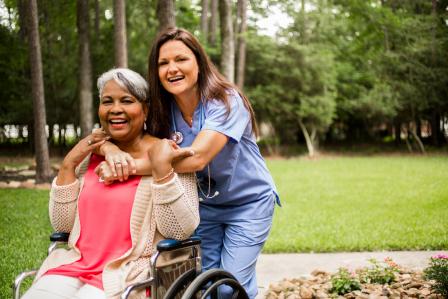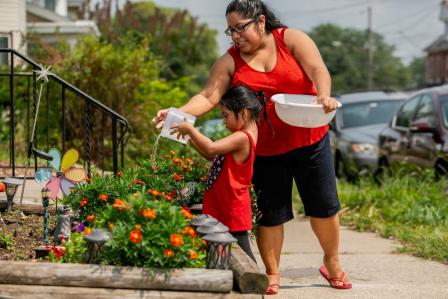Heat Islands and Equity
Heat islands impact some people more than others. As cities face higher temperatures, longer and more intense heat waves, and a stronger heat island effect, many local governments are increasingly focused on protecting the people who are most vulnerable to extreme heat. To accomplish this, many local governments are applying environmental justice principles in their efforts to mitigate heat islands and prepare for extreme heat events.
These tabs explain the link between urban heat and equity, describe general approaches local governments have used to address heat equity, and provide examples of specific actions three communities have taken to manage heat in an equitable manner.
- What is Heat Equity?
- What is the Heat and Equity Connection?
- How can Heat Equity be Addressed?
- Local Heat Equity Examples
What is Heat Equity?
Heat equity refers to the development of policies and practices that mitigate heat islands and help people adapt to the impacts of extreme heat in a way that reduces the inequitable distribution of risks across different populations within the same urban area. Heat equity can be improved by ensuring that all residents have equal access to local heat island mitigation programs and tailoring a city’s response to severe heat to meet the unique needs of the most at-risk residents. Some local governments have found that working to reduce their heat islands in this way can help at-risk residents and create more livable cities for everyone.
- Learn about Heat Island Cooling Strategies for mitigation, including green roofs, cool roofs, cool pavements, and trees and vegetation.
- Learn about Adapting to Heat, including adaptation responses such as early warning systems and cooling centers.
What is the Heat and Equity Connection?
A growing body of research points to “intra-urban” heat islands, or areas within a city that are hotter than others due to the uneven distribution of heat-absorbing buildings and pavements, and cooler spaces with trees and greenery. These differences can result from disparities in the way communities are planned, developed, and maintained.
There are often correlations between hotter neighborhoods and demographic characteristics of residents, with factors such as race and income often playing a role in who bears the brunt of extreme heat.[1] Groups at greater risk for heat-related health impacts include:
 Older adults (65+ years)
Older adults (65+ years)- Outdoor workersExit
- People with existing medical conditions
- Children, infants, and pregnant women
- Athletes
- People who live alone
- People who are homeless
- People with limited personal resources to deal with extreme heat (e.g., income, mobility).
Learn about Protecting Vulnerable Groups from Extreme Heat on the CDC website.Exit
Higher temperatures can compound factors that make at-risk individuals even more vulnerable to extreme heat. For example, EPA’s research finds asthma is more common among low-income and minority groups due, in part, to environmental factors. Hot, sunny days can make air quality worse because sunlight can react with air pollutants to form ground-level ozone – or smog – a major trigger of asthma. As a result, many people suffer disproportionately from exposure to lower air quality, hotter temperatures, and the ozone that forms from the combination of the two.
Excessive heat is a financial burden for low-income households. For instance, these households already typically pay proportionately more than the average household for energy costs, and also often live in energy-inefficient homes that are more expensive to keep cool. This makes it more difficult for low-income households to cope during a heat wave.[3] During the 1995 Chicago heat wave, the lack of air conditioning or the inability to afford it were factors in the higher death rates of low-income residents.[4]
How Can Heat Equity be Addressed?
Many local governments have found ways to create effective and equitable policies and programs to help protect residents most at-risk to extreme heat. Below are some common approaches local governments have used.
- Collect relevant data: While data on residents’ age, race, income, and location are typically available; data on certain heat risk factors such as existing health issues and social isolation can be harder to identify and track. Understanding where these residents live, where the heat hits hardest, and where these two intersect helps when assessing and designing equitable heat solutions.
- Provide information in multiple languages: Language barriers can prevent important information, such as heat wave warnings and notices about cool roof rebates, from reaching certain communities. Many jurisdictions now have policies that require information to be translated into their communities’ most widely spoken languages; and distributed through channels where they are more likely to reach intended audiences, such as supermarkets, transit hubs, and places of worship.
- Use effective messaging: Some local governments have found that the way they communicate about heat mitigation and adaptation measures is as important as designing them to be effective and equitable. For example, though the term “vulnerable populations”
 is often used to describe people with greater risk factors for heat impacts, many people may not think of themselves as “vulnerable.” Other local governments have found that referring to these residents as “at risk for” or “with a greater chance of” heat-related illness can be more effective for reaching out to them, as this focuses on the risk factors and not the individuals themselves. Engaging trusted messengers to communicate heat mitigation and adaptation measures is one strategy to ensure that the information reaches intended residents. Residents may be more likely to rely on information flowing from existing networks and leaders such as faith-based organizations or healthcare providers.
is often used to describe people with greater risk factors for heat impacts, many people may not think of themselves as “vulnerable.” Other local governments have found that referring to these residents as “at risk for” or “with a greater chance of” heat-related illness can be more effective for reaching out to them, as this focuses on the risk factors and not the individuals themselves. Engaging trusted messengers to communicate heat mitigation and adaptation measures is one strategy to ensure that the information reaches intended residents. Residents may be more likely to rely on information flowing from existing networks and leaders such as faith-based organizations or healthcare providers. - Structure programs to be widely accessible: Individual and household circumstances can limit a person’s ability to learn about and take advantage of heat island mitigation programs, including people with low incomes, those with limited mobility, or those who work non-traditional hours. For example, a tree giveaway event that occurs in the evening presents challenges for people who work nights or do not have access to adequate child care. To address the difficulty low-income residents can have in paying the upfront costs for a cool roof rebate program, some cities have provided grants or low-interest loans for such projects, including partnering with local nonprofits. Other localities have programs that fully subsidize cool roof installations in buildings that serve a public interest, such as affordable housing, schools, and shelters.
- Design programs to benefit renters: Heat mitigation strategies, such as planting trees and installing green or cool roofs, often involve modifying one’s property. As a result, renters who have little if any control over their property conditions may have limited options to reduce their heat exposure. One way local governments typically work around this barrier is by creating incentives for developers and owners of multi-family housing to incorporate heat mitigation strategies into their building design and retrofits.
Additional Resources
- Climate Change and Extreme Heat: What You Can Do to Prepare (EPA and CDC)
- Mapping the Vulnerability of Human Health to Extreme Heat in the United States (EPA)
- National Integrated Heat Health Information System (National Integrated Heat Health Information System, NIHHIS)EXIT
- Story Map on Protecting Outdoor Workers from Heat Illness (NIHHIS)EXIT
- Extreme Heat Safety Social Media Toolkit (FEMA)EXIT
[1] Jesdale, B.M., R. Morello-Frosch, and L. Cushing. 2013. The racial/ethnic distribution of heat risk-related land cover in relation to residential segregation. Environmental Health Perspectives 121(7):811–817. Available: http://doi.org/10.1289/ehp.1205919.
[2] Klinenberg, E. 2015. Heat Wave: A Social Autopsy of Disaster in Chicago. University of Chicago Press.
[3] Drehobl, A. and L. Ross. 2016. Lifting the high energy burden in America’s largest cities: How energy efficiency can improve low-income and underserved communities. ACEEE. April.
[4] Klinenberg, E. 2015. Heat Wave: A Social Autopsy of Disaster in Chicago. University of Chicago Press
